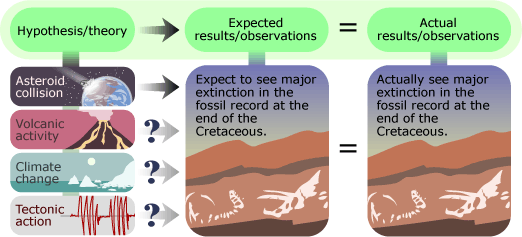Scientific ideas are always open to question and to new lines of evidence, so although many observations are consistent with the asteroid hypothesis, the investigation continues. So far, the evidence supports the idea that a giant asteroid struck Earth at the end of the Cretaceous — but did it actually cause most of the extinctions at that time? Some observations point to additional explanations. Further research (much of it spurred by the asteroid hypothesis) has revealed the end of the Cretaceous to be a chaotic time on Earth, even ignoring the issue of a massive asteroid collision. Volcanic activity peaked, producing lava flows that now cover about 200,000 square miles of India; major climate change was underway with general cooling punctuated by at least one intense period of global warming; sea level dropped and continents shifted with tectonic movements. With all this change going on, ecosystems were surely disrupted. These factors could certainly have played a role in triggering the mass extinction — but did they?
In short, the evidence points to several potential culprits for the mass extinction. Which is the true cause? Well, perhaps they all are.
Just as the extinction of an endangered species today may be traced to many contributing factors (global warming, habitat destruction, an invasive predator, etc.), the KT mass extinction may have been triggered by several different agents (e.g., volcanism and an asteroid impact, with a bit of climate change thrown into the mix). If this is indeed the case and multiple causes were in play, teasing them apart will require a more integrative approach, exploring the relationships between abiotic factors (like asteroid impacts and sea level change) and extinction: which groups survived the mass extinction and which did not? Birds, for example, survived the extinction, but all other dinosaurs went extinct. What does this tell us about the cause of the extinction? Are there different patterns of extinction in different ecosystems or different parts of the world? Do these differences point to separate causal mechanisms?
A VOLCANIC EPILOGUE
Posted January 2018
Research into the causes of the KT mass extinction has indeed continued since the original publication of this module. In particular, since volcanic activity has been implicated in several other mass extinctions, scientists have wondered about the potential interrelationships between the volcanism in India (known as the Deccan Traps), the Chicxulub meteor impact, and the mass extinction. Recent evidence, in the form of ever more precise dates on KT rocks, shows that the Deccan eruptions began before the meteor impact, but more than doubled their flow rate immediately afterwards. Modeling and several other lines of evidence suggest that the seismic energy produced by the meteor impact could have triggered eruptions and been the cause of increased volcanism half way around the world — so the fact that this large volcanic province was produced at the same time that a massive meteor struck Earth was probably not a coincidence! This hypothesis explains much of what we know was occurring on Earth at the time. The initial Deccan volcanism would have produced greenhouse gases, leading to global warming. Then an asteroid impact caused a huge disruption to Earth’s ecosystems directly, as well as a surge in volcanic activity, which likely further exacerbated the environmental damage caused by the impact. Evidence still points to the meteor as the main cause of the KT mass extinction, but as additional data are uncovered, our understanding of this tumultuous moment in Earth history becomes ever sharper. To keep up to date on the latest research on this topic, check in with the scientists themselves.
Scientific ideas are inherently tentative, and research into the causes and dynamics of the KT extinction continue today. Learn more about the ongoing nature of science.

